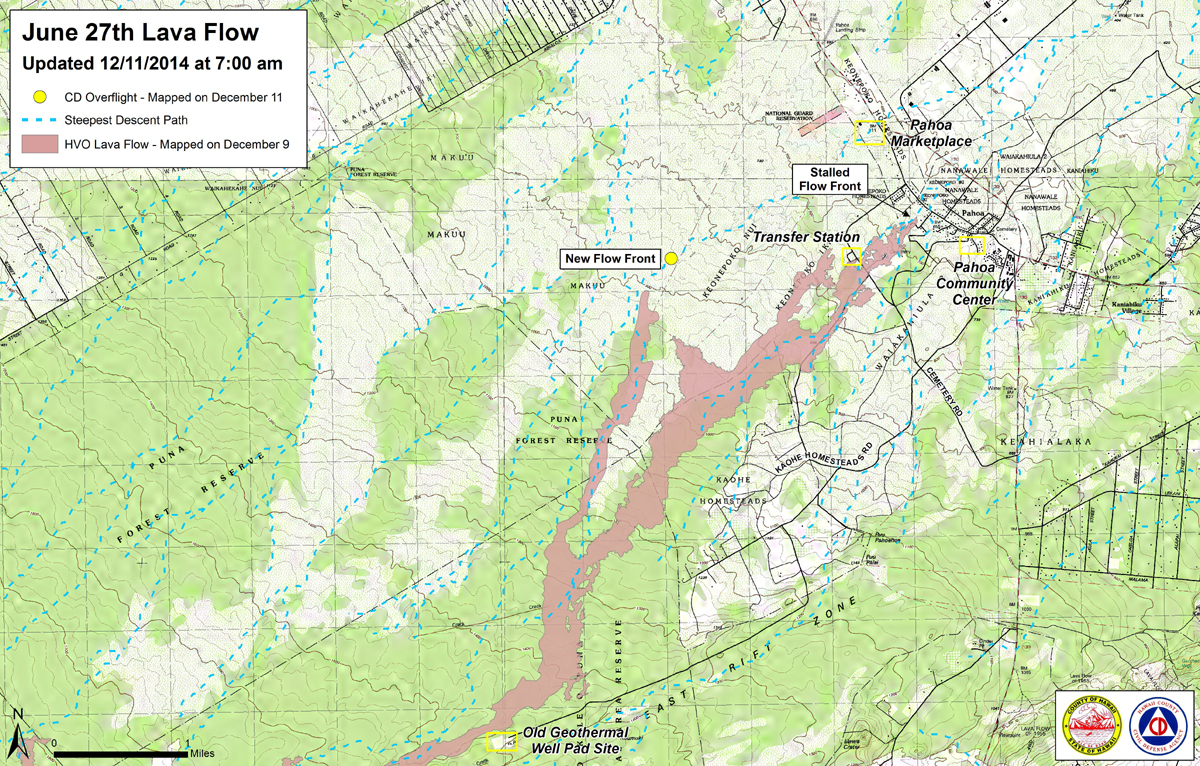(ABOVE MAP) Inset from today’s Civil Defense Lava Flow Map (Updated Thursday, 12/11/14 at 7 a.m.)
NEWS BRIEFS
- The lava flow front had advanced 340 yards since yesterday and the front remains 1.9 miles upslope of the Highway 130 and Pahoa Village Road intersection.
- Smoke conditions were moderate this morning in the immediate area with a light north wind blowing the smoke in a south southeast direction.
INSIGHTS
Today’s Civil Defense message:
RECENT RELATED VIDEO
This video was taken by Mick Kalber during yesterday’s overflight (Dec. 10) and also includes yesterday’s civil defense message (Dec. 10).
PRIMARY SOURCES

This morning’s assessment shows that the flow front remains active with burning along the edges and continues to advance in a north/northeast direction. The active flow had advanced approximately 340 yards since yesterday and the front remains approximately 1.9 miles upslope of the Highway 130 and Pahoa Village Road intersection. Current activity does not pose an immediate threat to area communities and Civil Defense and Hawaiian Volcano Observatory personnel are maintaining close observations of flow activity. Residents down slope will be kept informed of any changes in flow activity, advancement, and status.
Smoke conditions were moderate this morning in the immediate area with a light north wind blowing the smoke in a south southeast direction. Smoke conditions may increase in some areas and residents that may be sensitive or have respiratory problems are advised to take precautions and to remain indoors.
The Pahoa Village Road remains open to all traffic and motorists are advised to exercise caution as some utility pole protection material remains in place. Everyone is asked to please respect the residents of the area who were affected by the lava flow and to not trespass on private property.
Once again we would like to thank everyone for your patience and understanding and your cooperation and assistance is greatly appreciated.Hawaii County Civil Defense on Dec. 11 at 8 a.m. HST

Civil Defense Lava Flow Map – Updated Thursday, 12/11/14 at 7:00 am

Kīlauea Volcano continues to erupt at its summit and within its East Rift Zone. A narrow lobe of lava west of the flow field below the crack system remains active and advanced ~275 m (~300 yds) since yesterday. The leading edge of this lobe is approximately 3.0 km (1.9 miles) above the intersection of Pāhoa Village Road and Highway 130, near the Pāhoa Marketplace. A gradual inflationary tilt trend continues today at Kīlauea’s summit.
June 27th Lava Flow Observations: HVO, along with Civil Defense, is monitoring a narrow flow lobe that branches off the west edge of the flow field below the crack system. Civil Defense reported, this morning, that the leading edge of the flow was about 3.0 km (1.9 mi) upslope from the intersection of Pāhoa Village Road and Highway 130, near the Pāhoa Marketplace. The active lobe is following a steepest-descent path that takes the flow towards the intersection of Pāhoa Village Road and Highway 130, in the vicinity of the Pāhoa Marketplace. The flow front has also entered a burn scar which has significantly reduced the amount of smoke seen from the flow front in our webcams. In addition to this active lobe, a breakout from the lava tube on December 5, about 2.6 km (1.6 mi) from Puʻu ʻŌʻō remains weakly active. The breakout is about 1 km (0.6 mi) long, and has widened the flow field in this area by about 200 m (220 yd).
Puʻu ʻŌʻō Observations: There was weak deflationary tilt at Puʻu ʻŌʻō over the past several hours which has leveled off for now. All other monitoring data indicate no significant changes at Puʻu ʻŌʻō. Seismic tremor is low and steady, and webcams revealed no strong variations in the pattern of glow from degassing vents or the configuration of the crater floor. GPS-measured deformation across the cone has shown no net extension nor contraction since July. The most recent measurement of sulfur dioxide emissions from the East Rift Zone was about 250 tonnes per day on November 26, 2014.
Summit Observations: The inflationary ground tilt at the summit continues today. The summit lava lake showed the usual fluctuations associated with changes in spattering behavior, which are also manifested as variations in tremor amplitudes. Small amounts of particulate material were carried aloft by the plume. The average emission rate of sulfur dioxide was 4,100 tonnes/day for the week ending on December 9 USGS Hawaiian Volcano Observatory on Dec. 11 at 9:04 a.m. HST

by Big Island Video News9:33 am
on at
STORY SUMMARY
The lava flow is picking up speed as it continues its advance towards Pahoa Marketplace.